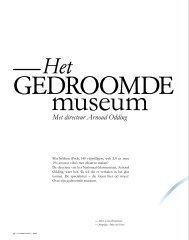Dichter op de Huid - O dubbel d
Dichter op de Huid - O dubbel d
Dichter op de Huid - O dubbel d
Create successful ePaper yourself
Turn your PDF publications into a flip-book with our unique Google optimized e-Paper software.
intentions of others are of vital importance; friends and foes, sexual<br />
equals or <strong>op</strong>posites. Words are beautiful but the skin, its smell; its<br />
status is the <strong>de</strong>termining factor. Beautiful words fa<strong>de</strong> once the eyes<br />
see the skin and it is found wanting. We form our first impressions<br />
from the skin, from how our skin is <strong>de</strong>corated, from the clothes<br />
we cover our skin in. Skin becomes a cloth that we wash and<br />
bathe, cover and uncover, paint, pierce and stretch and spray with<br />
antiperspirants. Our skin has become the billboard for our i<strong>de</strong>ntity.<br />
We have been manipulating our surface for at least ten<br />
thousand years. With the <strong>de</strong>vel<strong>op</strong>ments in technical possibilities<br />
merely the means and not the intentions have changed. From the<br />
simple application of mineral colorants on sparsely clothed skin<br />
such as red ochre, yellow ochre, white ash and clays continuously<br />
being discovered in archaeological sites from African caves to the<br />
American ukurùs. A red dye which is taken from the fruit with the<br />
same name or charcoal from Egypt which was used to make the eyes<br />
more striking, or the green pow<strong>de</strong>red malachite that was used as<br />
eye shadow and the red ochre or carmine with which pe<strong>op</strong>le ma<strong>de</strong><br />
their lips look fuller; these are the organic varieties of our mo<strong>de</strong>rn<br />
techniques of <strong>de</strong>ceit. Techniques employed by the fashion industry<br />
on a daily basis.<br />
Less subtle and more permanent scratches, tattoos and<br />
piercings originated thanks to our increasing technical ingenuity. As<br />
soon as a technique becomes available, it is appreciatively ma<strong>de</strong> use<br />
of on our own bodies too. The more gruesome the technique with<br />
which we manipulate our skin, the more likely the technique was<br />
originally used in initiation rites; rites which marked the transition<br />
of a person from one phase of life to the next: hundreds of scratches<br />
on the skin turned a boy into a man, patterned scars on the faces of<br />
young girls ma<strong>de</strong> them women, Mandan priests allowing themselves<br />
to be hung from hooks on their chests and backs during the Okipa<br />
ceremony, the most holy of ceremonies for their Indian tribe. Closer<br />
to home, artists who gouge out their own skin to prove a point.<br />
The heavy-han<strong>de</strong>d manipulation of the skin, brought us closer to<br />
ourselves, enabled us to un<strong>de</strong>rgo personal <strong>de</strong>vel<strong>op</strong>ment and achieve<br />
a higher state of consciousness, whatever that may have meant to us.<br />
healthier, smoother, tighter, shinier, matter, more coloured, more<br />
pierced, gaunter, extremer contours, extremer extremes. We have<br />
become obsessed.<br />
The cosmetics of the skin have become an integral part of<br />
our fashion image over the last dozen or so years, of our daily ritual,<br />
of the i<strong>de</strong>ntity we wish to portray, of the i<strong>de</strong>ntity we wish to have.<br />
Furthermore, everything appears to be possible. If we have past the<br />
age of fifty we must still be sexually attractive, with tight skin. Even<br />
though for most women, there is no biological need for this. We<br />
have to be virile and our untameable forces have to manifest, which<br />
is why we leave a false scent using tattoos, hooks and high-tech skins.<br />
But who is misleading whom these days?<br />
We are being palmed off with eternal youth in pots that<br />
bombard our surface from two si<strong>de</strong>s, extra healthy bacteria from the<br />
insi<strong>de</strong> and nan<strong>op</strong>articles from the outsi<strong>de</strong>. We are ma<strong>de</strong> to believe in<br />
eternal vitality, the skin remains skin with its own physics and its own<br />
i<strong>de</strong>ntity, regenerating or <strong>de</strong>generating. Sooner or later everything<br />
will perish. He who knows his skin knows himself.<br />
About / On / IN / Un<strong>de</strong>r thE skin<br />
Essay The billboard of our i<strong>de</strong>ntity<br />
Our daily ritual<br />
Over the last 150 years, a true industry has <strong>de</strong>vel<strong>op</strong>ed around<br />
seduction and <strong>de</strong>ceit, but also around the sacred function of skin.<br />
Fuel for cosmetics factories: an increase in the ability to see more<br />
pe<strong>op</strong>le than you could know, first in paintings, then in photos, on<br />
television and Internet. On a daily basis we have seen many unknown<br />
faces pass us by, we were not able to curb our obsession with seeing<br />
any longer. Our visual perspective has increased, and with this<br />
our <strong>de</strong>sire to resemble others. Others who look better, younger,<br />
10 Nationaal Glasmuseum Leerdam / Fort Asperen Skin Deep / <strong>Dichter</strong> <strong>op</strong> <strong>de</strong> huid 11



